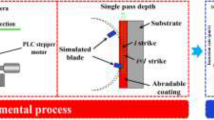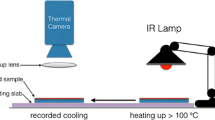Abstract
This article presents an investigation of the temperature changes in dry sliding contact for braking applications. An original metrology method was developed using a special pad with a calcium fluoride ‘window’ in its centre. As calcium fluoride is transparent to infrared radiation (up to 92% in 1–5 μm spectra), it allows access to the disc surface during friction for estimating its temperature using a two-colour pyrometer. Using this set-up, the surface temperature of the disc was successfully determined during friction. In addition, the temperature in the contact area was compared to that measured immediately outside the contact area; the difference between them proved to be very minimal (<5%). The effect of introducing a calcium fluoride ‘window’ on friction was also studied, and the results show that its use does not affect the friction coefficient. Finally, the wear mechanisms of the calcium fluoride were studied through the characterisation of the worn surfaces using several techniques.
















Similar content being viewed by others
References
Kasem, H., Bonnamy, S., Rousseau, B., Estrade-Szwarckopf, H., Berthier, Y., Jacquemard, P.: Interdependence between wear process, size of detached particles and CO2 production during carbon/carbon composite friction. Wear 263, 1220–1229 (2007)
Cristol-Bulthé, A.L., Desplanques, Y., Degallaix, G., Berthier, Y.: Mechanical and chemical investigation of the temperature influence on the tribological mechanisms occurring in OMC/cast iron friction contact. Wear 264, 815–825 (2008)
Bogdanovich, P.N., Tkachuk, D.V.: Temperature distribution over contact area and “hot spots” in rubbing solid contact. Tribol. Int. 39, 1355–1360 (2006)
Panier, S., Dufrénoy, P., Weichert, D.: An experimental investigation of hot spots in railway disc brakes. Wear 256, 764–773 (2004)
Abdel-Aal, H.A.: On the size of hot spots in the dry sliding of metals. Int. Commun. Heat Mass Transf. 26(3), 441b–450b (1999)
Thomas, J., Steven, C., Ball, K.J., Bedell, B.C.: Thermal cracking in disc brakes. Eng. Fail. Anal. 9, 63–76 (2002)
Dufrénoy, P., Bodovillé, G., Degallaix, G.: Damage mechanisms and thermomechanical loading of brake discs. Eur. Struct. Integr. Soc. 29, 167–176 (2002)
Eleod, A., Oucherif, F., Devecz, J., Berthier, Y.: Conception of numerical and experimental tools for study of the tribological transformation of surface TTS. Tribology (Elsevier Science) 36, 673–682 (1998)
Berthier, Y.: Third body reality, consequence and use of the third body to solve a friction and a wear problem. Wear, Materials, Mechanisms and Practice, Gwidon Stachowiack, Wiley Editor ISBN 0-470-1628-0, pp. 291–316 (2005)
Yvtushenko, A., Ivanik, E.: Determination of temperatures for sliding contact with application for braking systems. Wear 206, 53–59 (1997)
Day, A.J., Newcomb, T.P.: Dissipation of frictional energy from the interface of an annular disc brake. Proc. Inst. Mech. Eng. D Transp. Eng. 198(11), 201–209 (1984)
Santini J.J., Kennedy F.E.: Experimental investigation of surface temperatures and wear in disk brakes. Lubr. Eng. 31(8), 402–404, 413–417 (1975)
Qi, H.S., Day, A.J.: Investigation of disc/pad interface temperatures in friction braking. Wear 262, 505–513 (2007)
Denape, J., Laraqi, N.: Aspect thermique du frottement: mise en évidence expérimentale et éléments de modélisation. Méc. Ind. 1, 563–579 (2000)
Kennedy, F., Frusescu, D., Li, J.: Thin film thermocouple arrays for sliding surface temperature measurement. Wear 207, 46–57 (1997)
Kasem, H., Bonnamy, S., Berthier, Y., Dufrénoy, P., Jacquemard, P.: Tribological, physicochemical and thermal study of the abrupt friction transition during carbon/carbon composite friction. Wear 267, 846–852 (2009)
Siroux, M., Harmand, S., Desmet, B.: Experimental study using infrared thermography on the convective heat transfer of a TGV brake disc in the actual environment. Opt. Eng. 41(7), 1558–1564 (2002)
Kasem, H., Thevenet, J., Boidin, X., Siroux, M., Dufrénoy, P., Desmet, B., Desplanques, Y.: An emissivity-corrected method for the accurate radiometric measurement of transient surface temperatures during braking. Tribol. Int. 43, 1823–1830 (2010)
Thevenet, J., Siroux, M., Desmet, B.: Measurements of brake disc surface temperature and emissivity by two-color pyrometery. Appl. Therm. Eng. 30, 753–759 (2010)
Bair, S., Green, I., Bhushan, B.: Measurements of asperity temperatures of a read/write head slider bearing in hard magnetic recording disks. Trans. ASME J. Tribol. 113(3), 547–554 (1991)
Watremez, M., Drobecq, V., Guérin, J.D., Bricout, J.P.: De la similitude au comportement réel. Application aux disques de freins ferroviaires. Journées CETIM Frottement et usure: Conception et tests des solutions industrielles, France, Senlis, décembre (1999)
Bartys, H., Guérin, J.D. Bricout, J.P., Oudin, J.: Caractérisation de disques de freins ferroviaires revêtus de superalliages Co ou Ni. Mec. Ind. 675–682 (2000)
Thevenet, J.: Développement d’une métrologie thermique des contacts glissants en freiange. Thèse de doctorat, Université de Valenciennes (2009)
Liu, W., Ye, C., Chen, Y., Ou, Z., Sun, D.C.: Tribological behavior of sialon ceramics sliding against steel lubricated by fluorine-containing oils. Tribol. Int. 35, 503–509 (2002)
Acknowledgments
The present research work has been supported by the International Campus on Safety and Intermodality in Transportation, the Nord-Pas-de-Calais Region, the European Community, the Regional Delegation for Research and Technology, the Ministry of Higher Education and Research, and the National Centre for Scientific Research.
Author information
Authors and Affiliations
Corresponding author
Rights and permissions
About this article
Cite this article
Kasem, H., Dufrénoy, P., Desplanques, Y. et al. On the Use of Calcium Fluoride as an Infrared-Transparent First Body for In Situ Temperature Measurements in Sliding Contact. Tribol Lett 42, 27–36 (2011). https://doi.org/10.1007/s11249-010-9745-7
Received:
Accepted:
Published:
Issue Date:
DOI: https://doi.org/10.1007/s11249-010-9745-7




